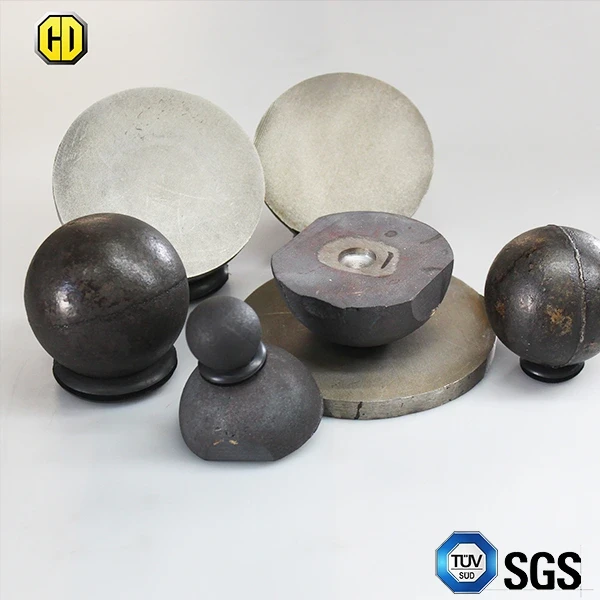Oct . 07, 2025 11:10 Back to list
Ball Mill Balls for Sale—High Hardness, Low Wear—Why Us?
Insider’s Take: What Matters When You’re Sourcing ball mill balls for sale
If you’ve been burned by inconsistent wear rates or mystery alloys, you’re not alone. Buyers keep telling me they want predictable performance, sane lead times, and proof—actual test data, not brochures. The Mine Special High Chromium Alloy Cast Iron Grinding Ball from KIZUN Industry Zone, Luquan, Sihijiazhuang city, Hebei, China, has been popping up in my notes more often lately—and for good reasons.

What’s changing in the grinding media market?
Two trends: higher Cr content for tougher, more abrasion-resistant balls, and tighter QA—think heat-treatment profiling and traceability codes. Energy costs are stinging plants; extending charge life by even 15% can shift the OPEX math. Honestly, some mills still chase the cheapest ton. But many customers say the switch to stable high-chrome has cut unplanned downtime (liners thank you later).
Product snapshot
| Parameter | Spec (typical) | Notes |
|---|---|---|
| Material | High chromium white cast iron | ASTM A532-class family; martensitic matrix + M7C3 carbides |
| Chrome content | ≈10–28% Cr | Grade selection based on ore abrasiveness and pH |
| Diameter range | 10–140 mm | Tight roundness; custom mixes available |
| Hardness (HRC) | Surface 60–66; core 56–62 | ASTM E18 tested; real-world may vary by size |
| Density | ≈7.6–7.8 g/cm³ | Affects mill power draw and throughput |
| Color | Black | As-cast + tempered finish |
Process flow (how they’re made and proven)
- Melting & alloying: Charge steel + FeCr; controlled additions for 10–28% Cr and C balance.
- Casting: Precision molding; gating tuned to reduce porosity and shrinkage.
- Heat treatment: Quench + temper to achieve martensitic matrix; batch curve recorded.
- Testing: Hardness (ASTM E18), microstructure etching (ASTM E407), abrasion benchmarks (ASTM G65), impact (ISO 148-1, as applicable).
- Traceability: Heat number stamped/encoded; COA per lot.
- Service life: Often 1.5–3× vs low-chrome in clinker and porphyry copper—your mileage depends on media size and pulp chemistry.
Where they’re used (and why)
Cement plants, mining concentrators, chemical and refractory grinding, even petroleum-related solids processing. Advantages include solid wear resistance, lower breakage rate, and more consistent grind size. Surprisingly, the stability in hardness distribution cuts “spiky” PSD tails in some mills—operators notice.
Vendor comparison (field-notes style)
| Vendor | Chrome control | Heat treatment | QA/Certs | Lead time |
|---|---|---|---|---|
| Chengda (Hebei) | Tight (10–28% with COA) | Recorded quench/temper curves | ISO 9001; ASTM-based tests | Around 2–4 weeks ex-works |
| General Importer | Mixed; batch variability | Partial documentation | COC only | Uncertain (trans-ship) |
| Low-cost Foundry | Broad spec | Basic temper | Limited testing | Fast, but variable |
Customization
Size mix (10–140 mm), chrome tier, and heat-treatment profile per ore type or mill design. Packaging and mill charge modeling on request. To be honest, the pre-sale metallurgical consult often saves more than the media discount.
Real-world cases
- Cement clinker line (3.2×13 m mill): shift to 20–30–50 mm blend cut media consumption ≈18% and trimmed kWh/t by 3.5% over 90 days.
- Gold plant (SAG-ball hybrid): using 100–125 mm high-Cr in secondary mill reduced breakage events to near-zero; throughput up ≈2% with steadier P80.
Feedback has been blunt: “We stopped babysitting the charge.” That’s what you want from ball mill balls for sale, right?
Compliance and documentation
Supplier provides COA with heat number, chemical analysis, hardness map, and (on request) abrasion test data. Works to ISO 9001 QMS. Materials align with ASTM A532 guidance for abrasion-resistant irons. It seems basic—but not everyone does it.
If you’re shortlisting ball mill balls for sale, put test protocols in the PO: hardness (ASTM E18), abrasion (ASTM G65), and impact (ISO 148-1). Keeps everything honest.
Authoritative citations
- ASTM A532/A532M – Standard Specification for Abrasion-Resistant Cast Irons.
- ASTM E18 – Standard Test Methods for Rockwell Hardness of Metallic Materials.
- ASTM G65 – Standard Test Method for Measuring Abrasion Using the Dry Sand/Rubber Wheel Apparatus.
- ISO 9001:2015 – Quality Management Systems Requirements.
-
Expert Insights on Fabrica de Molinos de Bolas: Industry Trends & Global Applications
NewsNov.24,2025
-
Expert Insights on Fabricantes de Bolas de Molienda de Acero: Global Applications & Trends
NewsNov.23,2025
-
Leading Fabricantes de Bolas de Molienda: Your Ultimate Guide to Grinding Balls
NewsNov.23,2025
-
Fabricante de Bolas de Molienda – Quality Grinding Balls for Efficient Industry
NewsNov.23,2025
-
Trusted Proveedores de Medios de Molienda for Efficient Industrial Grinding
NewsNov.22,2025
-
Proveedores de Bolas de Molienda: Your Guide to Top Grinding Ball Suppliers & Industry Insights
NewsNov.22,2025
Realted Products
















